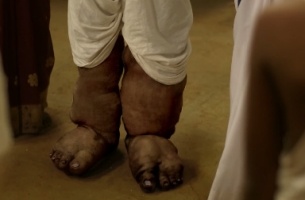
How Advertising Is Helping Eradicate Disease in India

After a several-year-long campaign, India was declared polio-free in 2014 – an immense feat for a country of its size and diversity. And the country’s next big health push is tackling elephantiasis (a.k.a. filaria), a totally avoidable disease that threatens a staggering 500 million people in India. It can cause disability and disfigurement among those infected, but many people are complacent when it comes to prevention, in-part due to ill-informed apathy and the length of time it takes to begin showing signs – eight to 10 years. To target the problem and encourage the population to take advantage of the free medication on offer, the Indian Ministry of Health & Family Welfare (MOHFW) and the Sabin Vaccine Institute of the US enlisted Ogilvy & Mather Mumbai to create one of the country’s largest ever health campaigns. The launch film, entitled ‘Giant Footprints’ and directed by Little Lamb Films’ Bauddhayan Mukherji, is a fairy tale-like story of a group of people excitedly following a trail of oversized footprints and finding an elephantiasis sufferer at their crest. LBB’s Addison Capper spoke with South Asia, Ogilvy ECD Sumanto Chattopadhyay to find out advertising’s importance in keeping the nation healthy.
LBB> Why do you think MOHFW has struggled so much with combating elephantiasis?
SC> Tackling any public health issue is a struggle in a country like India. Our population is enormous. And a large part of it is poor, illiterate and prey to superstition – that’s why it shies away from hospitals and public medicine. In the case of elephantiasis, preventative tablets were earlier distributed door-to-door but, often, people did not consume them. What complicates things further is that the symptoms of the disease show up to 8-10 years later. This makes it hard for people to grasp that they are at risk.
This time around, the MOHFW has launched the drug administration drive on an unprecedented scale. Our belief is that because the target group is now getting exposed to the advertising campaign, they will be far more receptive to the medication.
LBB> This is one of India's largest public health campaigns. Just how big a task is it to eliminate the disease?
SC> 500 million people are at risk in India. That is why there is a crying need to tackle it. The same statistic tells you why the task is mammoth, especially when you consider that many of this number live in far-flung villages that are difficult to physically reach.
LBB> What were you thinking when you first got the brief to undertake this campaign?
SC> To be able to work on a campaign that could reap such a rich health dividend for my country seemed like a wonderful opportunity and privilege.
LBB> What kind of added pressure does working on such an important campaign bring?
SC> When you undertake a project like this, you feel that there is no room for failure. The whole country is watching you. And depending on you.
LBB> What are your views on the importance of advertising in eradicating diseases and keeping people healthy?
SC> Advertising plays a pivotal role in the health of a nation. Last year, India was declared polio free. This was the culmination of a several-year-long campaign (also created by Ogilvy) in which people were educated about the criticality of inoculation. Myths and superstitions about the supposed harmfulness of the polio vaccine had to be dispelled there too. India’s biggest movie star Amitabh Bachchan – who has the image of an elder statesman – was the brand ambassador. In a series of advertising films he literally cajoled, urged, even ordered people to get their children inoculated. Such was the level of trust that people had in Bachchan, they complied – even though they might not have been fully convinced by the facts. I think the success of that campaign has made the path a little easier now for subsequent government health programs.
LBB> It’s refreshing to see that the Giant Footprints film doesn't just take a dark, depressing approach to highlighting the issue. The whole idea of following the giant footsteps is really quite magical – like a fairy tale – but still gets the point across. How did you end up at that idea?
SC> We knew that we had to be fairly direct and straightforward about the information being imparted in the film. It was important that certain key facts be put in the mouth of an expert – in this case the health worker. The more we thought about it, the more strongly we felt that putting a patient at the heart of the story would be a great idea as well. We thought that the patient playing an active role and saying that it may be too late for him, but others should take heed and protect themselves, would make the message hit home. We took care to portray him as an everyman with a family – and not somebody who is shunned, isolated and relegated to the margins of society.
But all this defined the climax of the film. What I felt was crucial was that the build-up to the climax be intriguing. The approach had to grab attention, make viewers curious and then reveal the truth.
LBB> Is the man in the spot an actual elephantiasis sufferer or an actor?
SC> Despite our efforts to find a real patient who could act and was willing to work during our big holiday, Diwali (which was the only time available for the shoot), we were unsuccessful. So our next best option was to create silicon prosthetics from a photograph of an actual filaria patient. We wanted to make sure the legs were replicas of a real-life patient’s legs and that no exaggeration of the features was done. We lucked out here because in the past prosthetics were not made in India, but now there is one art director in Bollywood, Prasun Basu, who creates high-quality prosthetics. Our director Bauddhayan [Mukherji, aka Buddy] identified him and, working closely with him, we got the legs we needed.
LBB> How did working on this campaign affect you personally?
SC> Over the years I have seen a number of people on the street with this condition but never knew what caused it and how prevalent it was. Working on the campaign made me realise that many Indians suffer from it and yet the suffering is unnecessary – given that it is so easy to prevent. I feel it is a privilege to be able to help reduce suffering in the world.
LBB> Are there any more elements to the campaign that are set to be released soon?
SC> Television is the medium with the widest reach in India. Even some of the remotest villages have it. A person who cannot read or write can still absorb information through it. Which is why it is the lead medium for a mass campaign like ours. Radio is a practical and cost-effective medium, so that too is part of our mix. Of course, there is print as well for the reading public. Billboards may follow. Finally, we are also using YouTube and social media to reach opinion leaders – their role cannot be discounted as influencers in breaking down barriers.
LBB> Are there any other points you'd like to make?
SC> In India, creating any ad campaign is a cultural challenge. Our country is more like a continent – with a multiplicity of languages, customs, habits, beliefs and socio-economic classes. So being able to find an idea that appeals across the board is not easy. One has to apply the fine art of creating simple messaging that is at the same time riveting. I sincerely hope that we have succeeded.
Time will tell.











